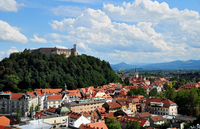4 cities

Ljubljana
Ljubljana is the capital of Slovenia, which lies in the northwest part of Southeast Europe. The city, with a population of about 300,000, is at the center of the national road network. Highways connect the city to other parts of the country and other cities in the region, e.g. Trieste, Maribor, Graz, Klagenfurt and Zagreb. Over 130,000 vehicles arrive in the city each day to join the 170,000 vehicles already in the city. Buses are the most frequently used form of public transport. Cyclists have a notable presence in traffic as well, particularly in the summer months. Annual CO2 emissions per capita: 3.41 tons.

Belgrade
Belgrade, the capital of Serbia, has a population of more than a million and is situated at the center of Southeast Europe. For centuries it has been a traffic hub between Central/Southeast Europe and the Middle East. About a half-million vehicles are registered in the city, which is why local roads are very busy and why the inhabitants have to deal with air pollution. These problems could be solved by improving public transport, e.g. by building a metro, as Belgrade is one of the few European cities of its size without a metro or a similar rapid public transport system. Nevertheless, many citizens – as many as three quarters – use public transport. Annual CO2 emissions per capita: 3.85 tons.

Budapest
Budapest is the capital of Hungary. It has roughly 1.7 million inhabitants, which is almost a fifth of the entire population of Hungary. All major roads in Hungary lead to Budapest and connect the city with all parts of the country. The road system design is similar to that of Paris, with avenues intersecting with circular bypass roads and leading to the city center. There are around 900,000 private cars in the city each day (a third of all private cars in Hungary); two thirds are registered in Budapest and a third outside the city. Annual CO2 emissions per capita: 5.8 tons.

Istanbul
Istanbul is the largest city in Turkey and an important cultural, economic and financial center with over 14 million inhabitants. Due to its strategic position between Asia and Europe, it is a junction of important transport routes, which has led to economic growth and a four-fold increase in population since 1970. The number of vehaicles has grown even more rapidly and now stands at approximately three million, which is eight times more than in 1980. It is expected that the number will continue to rise, as 640 cars are registered in the city each day. Such a large number of personal vehicles and heavy goods vehicles in Istanbul is causing gridlocks and increasing air pollution. Annual CO2 emissions per capita: 3.25 tons.



